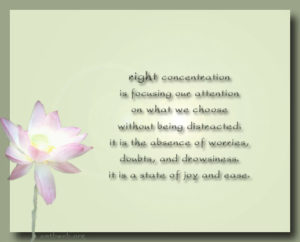
By John M. de Castro, Ph.D.
“We are not proving ourselves spiritually worthy of our material progress. We have not been neighborly, courteous, and kind upon the highway. Our lack of decency toward our fellow men is a definite black mark against us.” ~Cary T. Grayson
We often think of meditation or spiritual practice as occurring in quiet places removed from the hubbub of life. This is useful to develop skills and deep understanding. Unfortunately, most people do not have the luxury of withdrawing into solitary or monastic life. But it is possible to practice even in the midst of the chaos of everyday life. In fact, there are wonderful opportunities to practice presented to us all the time in the complexities of the modern world. I find that driving an automobile is an almost perfect context in which to practice the Buddha’s Eightfold Path, the Buddha’s prerequisites for the cessation of suffering; Right View, Right Intentions, Right Actions, Right Speech, Right Livelihood, Right Effort, Right Mindfulness, and Right Concentration.
Driving is a wonderful opportunity to practice Right View. The impermanence of everything is on display. No matter how bad or good the traffic condition we can be sure that they will change. By recognizing this we not only practice Right View but also relax and accept what is. Driving is also a situation that reflects how interconnected everything is including the thing we label self. Driving is a cooperative venture. Without everyone’s cooperation, there would be chaos on the roads. How other people drive effects how we drive at the moment and in the future. In this context if we take a moment to look, it is easy to develop Right View. We can also view the transitoriness of our thoughts and emotions as they arise and fall away in response to the experiences occurring while driving and our reactions to them, how this thing called self that we think of a permanent and static actually changes moment to moment in reaction to our experiences while driving. This is a tremendous learning experience and laboratory to develop Right View.
It is hard to find a better context than driving to observe our suffering, unsatisfactoriness, and its roots. While driving we seem to want everything to be exactly as we want it to be and when it isn’t we suffer. We want other drivers to drive the speeds we want so they are not in our way, we want traffic signals to always be green, we want the sun or other drivers’ high beams not to be in our eyes, we want a parking space to be available close to our destination, etc. In other words, we can learn, if we are observant of what is happening during driving, that our suffering is caused by our lack of acceptance of how things are. So, driving constitutes an ideal laboratory to practice Right View. We can learn to accept things as they are, to see things without judgment, to view the road and other vehicles just as they are, and to understand how we drive has consequences, affecting ourselves and others, in other words, we learn Right View.
We can quite readily practice Right Intentions while driving and this can lead to Right Actions. These intentions include the abandonment of unwholesome desires. If we drive with anger, impatience, selfishness, resentment we are likely to harm others and ourselves. The harm may not be major or direct, but indirect by affecting the other drivers in negative ways. Perhaps cutting another off produces anger in them that causes them suffering and elicits poor driving from them or anger and aggression toward others. Perhaps, not moving over to allow faster traffic to pass may induce impatience and elicit inappropriate passing on their part or simply to unnecessarily cause them to suffer. But sometimes direct physical harm to others can be produced as in the case of driving while under the influence of drugs or alcohol. But if we practice Right Intentions with sincere intentions to create good and happiness, relieve suffering in ourselves and others, and not harm any living thing, we will drive sober, with courtesy, with tolerance and understanding, with kindness and good will. When I move over to allow someone to pass or I react to an aggressive driver with patience and tolerance, I sometimes reflect that I may have prevented great harm. Had I aggravated the other driver their emotions could provoke even more dangerous driving or resulted in later anger or aggression toward others. I like to reflect on the ripples of good that I may have created with unknown consequences well into the future.
Intentions are a key. They become our moral compass. They tend to lead us in the right direction even though we may at times stumble. It is often difficult or impossible to predict all of the consequences of our actions. It is also very difficult not to create some harm. Just the fact of driving is producing carbon emissions contributing to global warming. We need to try to not only have Right Intentions,” but to discern how even the best of intentions can sometime produce harmful outcomes. We have to sometimes balance the good we’re doing with the harm produced by the same actions. This requires Right View. This is where driving can be such a great practice as we can learn what works and what doesn’t and become better at discerning what are the wholesome Right Actions from those that produce more harm than good. But, if we form Right Intentions and aspire to create good and happiness we’ll be better drivers and will produce more harmony and good will on the roads and more importantly will be moving ourselves along the eightfold path.
There are many opportunities to practice Right Speech while driving. This can include non-verbal communications such as the use of turn signals. This is a form of Right Speech on the roads, communicating for the greater good. But, predominantly Right Speech is verbal. I have a bad habit of often reacting to driving situations with reflexive emotional expletives. This can occur in response to something as simple as being caught at a red light to another driver’s dangerous actions. This can also include gestures. They do no good and create harm in myself and sometimes aggravate and harm others. By practicing Right Speech. I work toward alleviating the suffering my habit produces in myself and others. I’ve started to develop a habit of simply reacting, rather than with expletives, with words such as “be safe” or a recitation of the loving kindness meditation wishes for health, happiness, safety etc. It’s a work in progress, but I can clearly feel the benefit when I do.
Right Livelihood. only applies literally to a few drivers on the road, such as truck drivers, taxi drivers, police, tow truck drivers, etc. But if we fall into the category of people who make their living driving it is good to reflect on the effects of our activities on others. Does our livelihood produce harm to others, such as delivering weapons, cigarettes, or harmful drugs, or driving animals to slaughter, or does it produce greater good and happiness? It is not ours to judge the “rightness” of other people’s occupations. This is a personal matter where intention matters, that must be reflected upon deeply by each of us. But driving is more frequently a secondary component of our livelihood, perhaps as a means to get to our workplace. So, it can be conceived as part of our livelihood. So, driving is for many an opportunity to reflect upon our Right Livelihood.
Once again, driving presents a great context to practice Right Effort. It takes substantial effort to drive mindfully. If one drives automatically as most of us do most of the time, there is little or no mindfulness and little or no effort. When we first get in the driver’s seat we have to set the intention to drive in such a way as to lessen suffering in ourselves and others, to drive with kindness, compassion, patience, and courtesy, to drop fear, anger, hatred, selfishness, and the survival of the fittest attitude, and to bring to our interactions with others on the road the intention to promote well-being and happiness. Right Effort is driving the “Middle Way.” That is not trying too hard and getting stressed about driving mindfully, and also not being lackadaisical, but rather to try but relax. Don’t beat yourself up when you’re not driving mindfully and congratulate yourself when you do. The “Middle Way” is where effort should be targeted.
Mindless driving is probably the norm. Most people navigate the roads and traffic while their minds are elsewhere, ruminating about the past, planning for the future, or off in fantasy and daydreams. This provides us with a terrific opportunity to practice Right Mindfulness. Jon Kabat-Zinn defined mindfulness as “paying attention on purpose, in the present moment, and nonjudgmentally, to the unfolding of experience moment to moment.” What better opportunity to practice this than while driving? Right Mindfulness while driving precludes the dangerous activities of texting or engaging in other distractions that are known to amplify the dangers of driving. Right Mindfulness makes us acutely aware of what is happening and how we’re feeling during every moment of our drive. This makes not only for a more enjoyable drive, but also for much better driving. Awareness of how we’re feeling and what’s producing those feelings, and how we’re reacting to them makes us better able to drive safely without emotional outbursts eliciting unsafe behaviors. Right Mindfulness while driving is not just part of the eightfold path it is a prerequisite for the practice of the seven other components of the path. So, driving mindfully is a fundamental practice and driving is a great situation for practice.
Right Concentration” is the practice of focusing the mind solely on one object or a specific unchanging set of objects. Mindfulness is paying attention to whatever arises, but concentration is paying attention to one thing to the exclusion of everything else. This is usually developed during contemplative practice such as meditation and is nearly impossible to practice while driving. But, improvement in attentional ability is a consequence of practicing Right Concentration in other contexts which can improve driving by reducing distractions and mind wandering. In addition, it is thought that Right Concentration requires Right Effort, Right Intention, and Right Mindfulness and these can be practiced and developed while driving. So, although driving is not a situation for the practice of Right Concentration directly, the prerequisites for Right Concentration can be practiced and the benefits of its development can be appreciated.
Driving the eightfold path is not easy. But, remember that it is a practice. Over time I have gotten better and better at it, but nowhere near perfect. Frequently the discursive mind takes over or my emotions get the better of me. But, by continuing the practice I’ve slowly progressed. I’ve become a better driver and I’ve become a more relaxed and happier driver. I arrive at my destination relaxed with a smile on my face as opposed to the anger and stress that used to accompany me there.
Can we drive ourselves to enlightenment? Probably not! But we can practice the eightfold path that the Buddha taught leads there. The strength of driving the eightfold path practice is that it occurs in the real world of our everyday life. Quiet secluded practice is wonderful and perhaps mandatory for progress in spiritual development. But for most people it only can occur during a very limited window of time. By extending the practice directly into the mainstream of our lives we can greatly enhance its impact. I like to keep in mind the teaching that actions that lead to greater harmony and happiness should be practiced, while those that lead to unsatisfactoriness and unhappiness should be let go. Without doubt, driving the eightfold path leads to greater harmony and happiness and as such should definitely should be included in our spiritual practice.
“It helps if you don’t see it as traffic but rather as thousands of individuals resolved to press on another day.” ~Robert Brault
CMCS – Center for Mindfulness and Contemplative Studies
This and other Contemplative Studies posts are available on Google+ https://plus.google.com/106784388191201299496/posts







